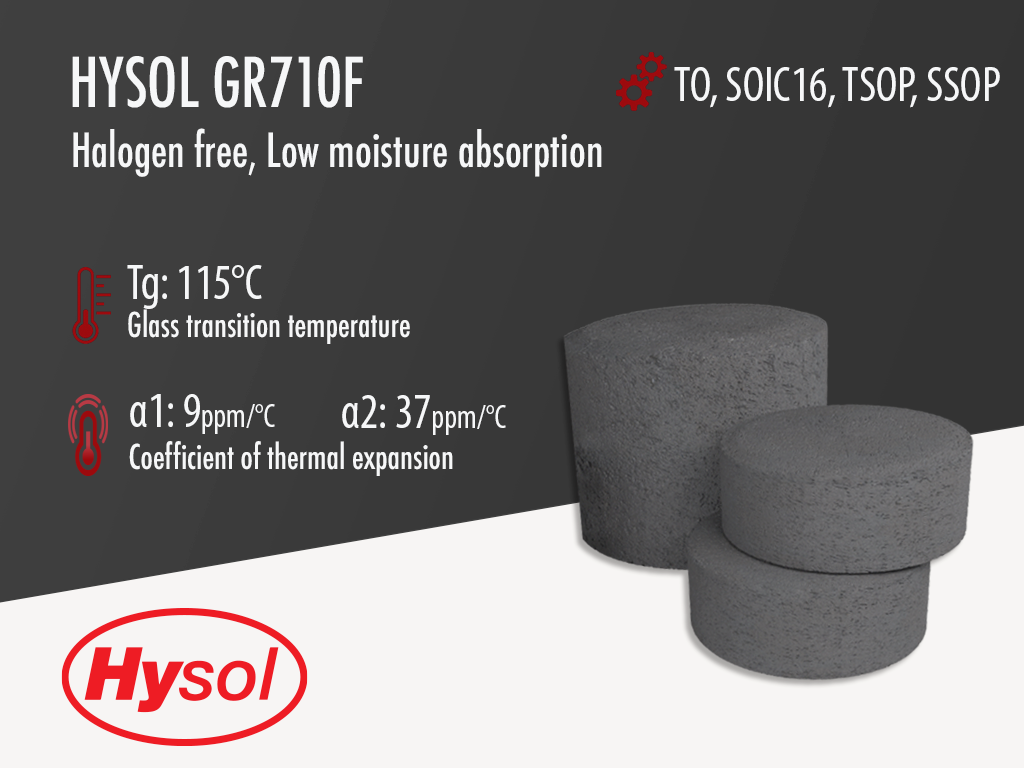Hysol GR710F | Black Epoxy Mold Compound
Harmonization Code : 3907.30.00.40 | Epoxy Mold Compounds containing by weight more than 70 % silicon dioxide
Main features
- Halogen free
- Low moisture absorption
- High reliability
Product Description
Hysol GR710F is a halogen free, black, spherical silica filled (75um cut size) semiconductor grade epoxy molding compound. It has high adhesion, low moisture absoprtion (0.2%) and a Tg of ~115°C.
Hysol GR710F is a technologically advanced, halogen free epoxy molding compound with good electrical performance, designed for high reliability applications with low moisture absorption requirements. Typical packages can be T0, SOIC16, TSOP and SSOP packages. It delivers outstanding performance and ease of use and it meets UL 94 V-0 flammability at 1/8 inch thickness. This product is a substitute for Hysol GR825-73B.
Available Version:
Technical Specifications
| General Properties | |
| Filler Content | 88 % |
| Specific Gravity Specific Gravity Specific gravity (SG) is the ratio of the density of a substance to the density of a reference substance; equivalently, it is the ratio of the mass of a substance to the mass of a reference substance for the same given volume. For liquids, the reference substance is almost always water (1), while for gases, it is air (1.18) at room temperature. Specific gravity is unitless. | 1.98 |
| Electrical Properties | |
| Volume Resistivity Volume Resistivity Volume resistivity, also called volume resistance, bulk resistance or bulk resistivity is a thickness dependent measurement of the resistivity of a material perpendicular to the plane of the surface. | 5.0x1016 Ohms⋅cm |
| Chemical Properties | |
| Moisture absorption | 0.2 % |
| Thermal Properties | |
| Glass Transition Temperature (Tg) Glass Transition Temperature (Tg) The glass transition temperature for organic adhesives is a temperature region where the polymers change from glassy and brittle to soft and rubbery. Increasing the temperature further continues the softening process as the viscosity drops too. Temperatures between the glass transition temperature and below the decomposition point of the adhesive are the best region for bonding. The glass-transition temperature Tg of a material characterizes the range of temperatures over which this glass transition occurs. | 115 °C |
| Thermal Conductivity Thermal Conductivity Thermal conductivity describes the ability of a material to conduct heat. It is required by power packages in order to dissipate heat and maintain stable electrical performance. Thermal conductivity units are [W/(m K)] in the SI system and [Btu/(hr ft °F)] in the Imperial system. | 0.86 W/m.K |
| Curing Conditions | |
| Transfer Pressure | 40 - 85 kg/cm2 |
| Transfer Time | 7 - 15 s |
| Physical Properties | |
| Spiral Flow @ 175°C | 93 cm |
Additional Information
GR710F Series Property Comparison
| Property | Unit | GR710F | GR710F (GN) | GR710F (GN26) |
|---|---|---|---|---|
| Epoxy type | - | - | MAR+LMW | MAR+LMW |
| Hardener type | - | - | MAR | MAR |
| Filler content | % | 89 | 87 | 87 |
| Filler type | - | Spherical | Spherical | Spherical |
| Filler cut size | μm | 75 | 75 | 75 |
| Spiral Flow | inches | 42 | 50 | 38 |
| Gel Time | sec | 30 | 30 | 31 |
| Tg by TMA | °C | 112 | ||
| CTE 1 | ppm/°C | 9 | ||
| CTE 2 | ppm/°C | 34 | ||
| DMA Modulus at RT | MPa | 28176 | 26451 | 26557 |
| DMA Modulus at 175°C | MPa | 752 | 620 | 523 |
| DMA Modulus at 260°C | MPa | 637 | 541 | 440 |
| Flexural modulus at 25°C | MPa | 24489 | 22000 | 24300 |
| Flexural strength at 25°C | MPa | 150 | 120 | 142 |
| Moisture absorption PCT24h | % | 0.20 | 0.29 | 0.25 |
| Volume resistivity | ×10¹⁵ Ω·cm | 65 | 60 | 50 |
| Comparative Tracking Index | V | 575 | 600 | 575 |



